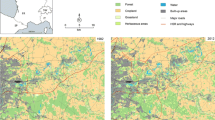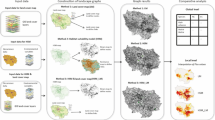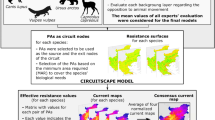Abstract
Graph-based analysis is a promising approach for analyzing the functional and structural connectivity of landscapes. In human-shaped landscapes, species have become vulnerable to land degradation and connectivity loss between habitat patches. Movement across the landscape is a key process for species survival that needs to be further investigated for heterogeneous human-dominated landscapes. The common frog (Rana temporaria) was used as a case study to explore and provide a graph connectivity analysis framework that integrates habitat suitability and dispersal responses to landscape permeability. The main habitat patches influencing habitat availability and connectivity were highlighted by using the software Conefor Sensinode 2.2. One of the main advantages of the presented graph-theoretical approach is its ability to provide a large choice of variables to be used based on the study’s assumptions and knowledge about target species. Based on dispersal simulation modelling in potential suitable habitat corridors, three distinct patterns of nodes connections of differing importance were revealed. These patterns are locally influenced by anthropogenic barriers, landscape permeability, and habitat suitability. And they are affected by different suitability and availability gradients to maximize the best possible settlement by the common frog within a terrestrial habitat continuum. The study determined the key role of landscape-based approaches for identifying the “availability-suitability-connectivity” patterns from a local to regional approach to provide an operational tool for landscape planning.





Similar content being viewed by others
References
Adriaensen F, Chardon JP, DeBlust GE, Swinnen E, Villalba S, Gulinck H, Matthysen E (2003) The application of least-cost modelling as a functional landscape model. Landsc Urban Plan 64:233–247
Allentoft ME, O’Brien J (2010) Global amphibian declines, loss of genetic diversity and fitness: a review. Diversity 2:47–71
Anderson RP, Lewc DA, Peterson T (2003) Evaluating predictive models of species’ distributions: criteria for selecting optimal models. Ecol Model 162:211–232
Andrén H (1994) Effects of habitat fragmentation on birds and mammals in landscapes with different proportions of suitable habitat: a review. Oikos 71:355–366
Baldwin RA (2009) Use of maximum entropy modeling in wildlife research. Entropy 11:854–866
Bodin Ö, Saura S (2010) Ranking individual habitat patches as connectivity providers: integrating network analysis and patch removal experiments. Ecol Model 221:2393–2405
Bollmann K, Graf RF, Suter W (2011) Quantitative predictions for patch occupancy of capercaillie in fragmented habitats. Ecography 34:276–286
Curado N, Hartel T, Arntzen JW (2011) Amphibian pond loss as a function of landscape change—a case study over three decades in an agricultural area of northern France. Biol Conserv. doi:10.1016/j.biocon.2011.02.011
Dale MRT, Fortin M-J (2010) From graphs to spatial graphs. Annu Rev Ecol Evol Syst 41:21–38
EEA (2007) CLC2006 technical guidelines. EEA technical report. European Environmental Agency, Copenhagen
Fahrig L (2003) Effects of habitat fragmentation on biodiversity. Annu Rev Ecol Evol Syst 34:487–515
Fahrig L, Pedlar J, Pope S, Taylor P, Wegener J (1995) Effect of road traffic on amphibian density. Biol Conserv 73:177–182
Foll M, Gaggiotti OE (2006) Identifying the environmental factors that determine the genetic structure of populations. Genetics 174:875–891
Fortuna MA, Gomez-Rodriguez C, Bascompte J (2006) Spatial network structure and amphibian persistence in stochastic environments. Proc R Soc Lond B 273:1429–1434
Galpern P, Manseau M, Fall A (2011) Patch-based graphs of landscape connectivity: a guide to construction, analysis and application for conservation. Biol Conserv 144:44–55
Garcia-Feced C, Saura S, Elena-Rossello H (2011) Improving landscape connectivity in forest districts: a two-stage process for prioritizing agricultural patches for reforestation. For Ecol Manag 161:154–161
Gauffre B, Estoup A, Bretagnolle V, Cosson JF (2008) Spatial genetic structure of a small rodent in a heterogeneous landscape. Mol Ecol 17:4619–4629
Hartel T, Nemes S, Öllerer K, Cogalniceanu D, Moga CI, Arntzen JW (2010) Using connectivity metrics and niche modelling to explore the occurrence of the northern crested newt Triturus cristatus (Amphibia, Caudata) in a traditionally managed landscape. Environ Conserv 37:195–200
Hu J, Jiang Z (2010) Predicting the potential distribution of the endangered Przewalski’s gazelle. J Zool 282:54–63
Janin A, Léna J-P, Ray N, Delacourt C, Allemand P, Joly P (2009) Assessing landscape connectivity with calibrated cost-distance modelling: predicting common toad distribution in a context of spreading agriculture. J Appl Ecol 46:1–9
Johansson M, Primmer CR, Sahlsten J, Merilä JU (2005) The influence of landscape structure on occurrence, abundance and genetic diversity of the common frog, Rana temporaria. Glob Change Biol 11:1664–1679
Joly P, Morand C, Cohas A (2003) Habitat fragmentation and amphibian conservation: building a tool for assessing landscape matrix connectivity. C R Biol 326:132–139
Kovar R, Brabec M, Vita R, Bocek R (2009) Spring migration distances of some Central European amphibian species. Amphib-Reptil 30:367–378
Lasso E (2008) The importance of setting the right genetic distance threshold for identification of clones using amplified fragment length polymorphism: a case study with five species in the tropical plant genus Piper. Mol Ecol Resour 8:74–82
Marulli J, Mallarach JM (2005) A GIS methodology for assessing ecological connectivity: application to the Barcelona Metropolitan Area. Landsc Urban Plan 71:243–262
McGarigal K, Cushman SA, Neel MC, Ene E (2002) FRAGSTATS: Spatial pattern analysis program for categorical maps. Computer software program produced by the authors at the University of Massachusetts, Amherst. http://www.umass.edu/landeco/research/fragstats/downloads/fragstats_downloads.html
McRae BH, Dickson BG, Keitt TH, Shah VB (2008) Using circuit theory to model connectivity in ecology, evolution, and conservation. Ecology 89:2712–2724
Miaud C, Guyétant R, Elmberg J (1999) Variation in life-history traits in the common frog Rana temporaria (Amphibia: Anura): a literature reviews and new data from the French Alps. J Zool 249:61–73
Minor ES, Urban D (2008) A graph-theory framework for evaluating landscape connectivity and conservation planning. Conserv Biol 31:297–307
Morueta-Holme N, Fløjgaard C, Svenning J (2010) Climate change risks and conservation implications for a threatened small-range mammal species. PLoS One 5:1–12
Opdam P, Steingröver E, Van Rooij S (2006) Ecological networks: a spatial concept for multi-actor planning of sustainable landscapes. Landsc Urban Plan 75:322–332
Pahkala M, Laurila A, Merilä J (2001) Carry-over effects of ultraviolet-B radiation on larval fitness in Rana temporaria. Proc R Soc Lond B 268:1699–1706
Palo JU, Schmeller DS, Laurila A (2004) High degree of population subdivision in a widespread amphibian. Mol Ecol 13:2631–2644
Pascual-Hortal L, Saura S (2006) Comparison and development of new graph-based landscape connectivity indices: towards the priorization of habitat patches and corridors for conservation. Landscape Ecol 21:959–967
Pascual-Hortal L, Saura S (2008) Integrating landscape connectivity in broad-scale forest planning through a new graph-based habitat availability methodology: application to capercaillie (Tetrao urogallus) in Catalonia (NE Spain). Eur J For Res 127:23–31
Pearce J, Ferrier S (2000) Evaluating the predictive performance of habitat models developed using logistic regression. Ecol Model 133:225–245
Pekkarinen A, Reithmaier LPS (2009) Pan European forest/non-forest mapping with Landsat ETM+ and Corine land Cover 200 data. J Photogramm Remote Sens 64:173–183
Pereira M, Segurado P, Neves N (2011) Using spatial network structure in landscape management and planning: a case study with pond turtles. Landsc Urban Plan 100:67–76
Philips SJ, Dudik M (2008) Modeling of species distributions with Maxent: new extensions and a comprehensive evaluation. Ecography 31:161–175
Philips SJ, Anderson RP, Schapire RE (2006) Maximum entropy modeling of species geographic distributions. Ecol Model 190:231–259
Ray N, Lehmann A, Joly P (2002) Modeling spatial distribution of amphibian populations: a GIS approach based on habitat matrix permeability. Biodivers Conserv 11:2143–2165
Rayfield B, Fortin M-J, Fall A (2010) The sensitivity of least-cost habitat graphs to relative cost surface values. Landscape Ecol 25:519–532
Richard Y, Armstrong DP (2009) The importance of integrating landscape ecology in habitat models: isolation-driven occurrence of north island robins in a fragmented landscape. Landscape Ecol 25:1363–1374
Rödder D, Kielgast J, Bielby J, Schmidtlein S, Bosch J, Garner T, Veith M, Walker S, Fisher M, Lötters S (2009) Global amphibian risk assessment for the panzootic chytrid fungus. Diversity 1:52–66
Safner T, Miaud C, Gaggiotti O, Decout S, Rioux D, Zundel S, Manel S (2010) Combining demography and genetic analysis to assess the population structure of an amphibian in a human-dominated landscape. Conserv Genet 12:161–173
Saura S, Pascual-Hortal L (2007) A new habitat availability index to integrate connectivity in landscape conservation planning: comparison with existing indices and application to a case study. Landsc Urban Plan 83:91–103
Saura S, Torné J (2009) Conefor Sensinode 2.2: a software package for quantifying the importance of habitat patches for landscape connectivity. Environ Model Softw 24:135–139
Sawyer SC, Epps CW, Brashares JS (2011) Placing linkages among fragmented habitats: do least-cost models reflect how animals use landscapes? J Appl Ecol 48:668–678
Schadt S, Knauer F, Kaczensky P et al (2002) Rule-based assessment of suitable habitat and patch connectivity for the Eurasian lynx. Ecol Appl 12:1469–1483
Taylor PD, Fahrig L, Henein K, Merriam NG (1993) Connectivity is a vital element of landscape structure. Oikos 68:571–573
Urban D, Keitt T (2001) Landscape connectivity: a graph-theoretic perspective. Ecology 82:1205–1218
Urban DL, Minor ES, Treml EA et al (2009) Graph models of habitat mosaics. Ecol Lett 12:260–273
Wang IJ, Savage WK, Shaffer HB (2009) Landscape genetics and least-cost path analysis reveal unexpected dispersal routes in the California tiger salamander (Ambystoma californiense). Mol Ecol 18:1365–1375
Ward DF (2007) Modelling the potential geographic distribution of invasive ant species in New Zealand. Biol Invasion 9:723–735
Wiens JA, Stenseth NC, Van Horne B, Ims RA (1993) Ecological mechanisms and landscape ecology. Oikos 66:369–380
Zetterberg A, Mörtberg UM, Balfors B (2010) Making graph theory operational for landscape ecological assessments, planning, and design. Landsc Urban Plan 95:181–191
Acknowledgments
Support for this work was partly provided from the EU-Interreg Alpine Space Program Econnect (reference number: 116/1/3/A) and the French Ministry of Ecology and Sustainable Development (DEB-ECOTRAM project). We would like to thank Santiago Saura for his advice on the subject and support in the use of the Conefor Sensinode software and Peter Vogt for constructive comments. Many thanks are also given to the members of the non-governmental organizations Avenir 38, LPO Isère, and CPN Savoie for the data provided for this study, and to the two anonymous referees for the constructive comments on the manuscript.
Author information
Authors and Affiliations
Corresponding author
Rights and permissions
About this article
Cite this article
Decout, S., Manel, S., Miaud, C. et al. Integrative approach for landscape-based graph connectivity analysis: a case study with the common frog (Rana temporaria) in human-dominated landscapes. Landscape Ecol 27, 267–279 (2012). https://doi.org/10.1007/s10980-011-9694-z
Received:
Accepted:
Published:
Issue Date:
DOI: https://doi.org/10.1007/s10980-011-9694-z




